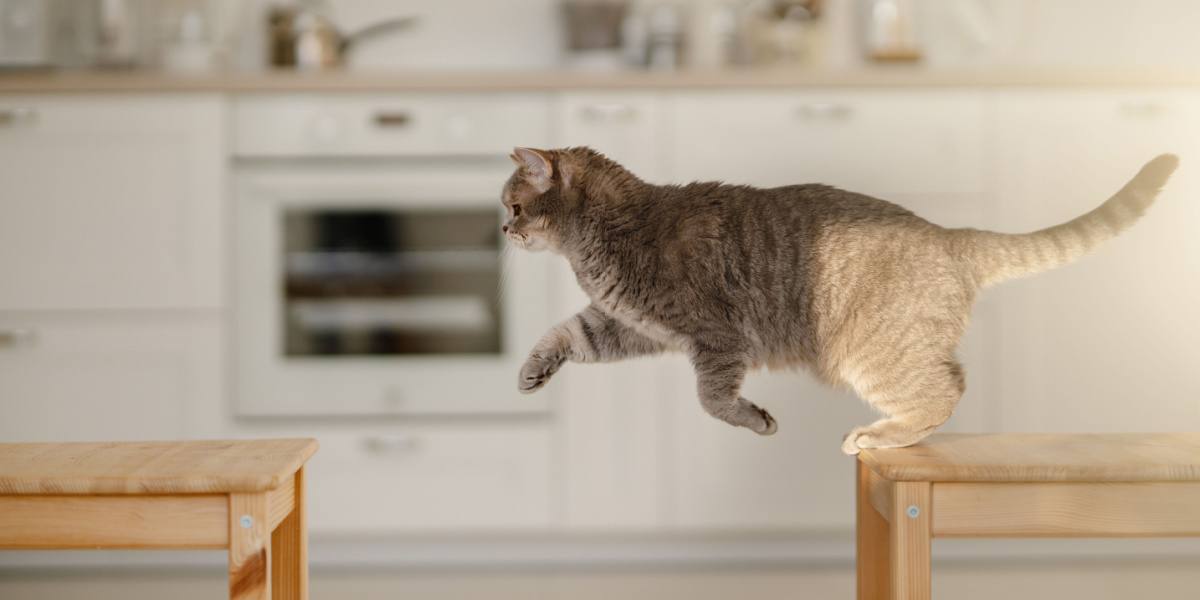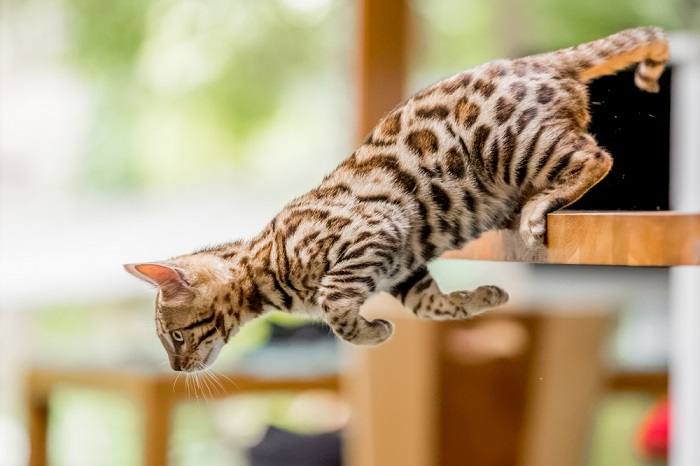
Does your cat jump up onto countertops or amuse themselves by leaping on and off their cat trees? Cats are known for their graceful athleticism and love of high places, but how high can an average house cat actually leap?
Cats are super flexible, which heightens their jumping ability. In fact, the average cat can jump up to six times their height in a single attempt! This has consequences for how you cat-proof your home and keep your kitties safe and sound.
Let’s have a look at the science behind the humble cat’s ability to achieve great heights.
Why Cats Need To Jump
The domestic cat we know and love today is descended from wild cats living in the deserts and plains of North Africa. These felines were prey as well as predator, and their ability to jump and climb helped them to evade trouble swiftly. Nowadays, the average cat is kept well protected in our homes, but they still retain many of the same physiological features.
The ability to jump and pounce was also necessary for their survival as it is an important hunting tactic. Cats are solitary hunters, and stealthily sneak up on birds and small mammals. Once close enough, they leap up into the air using their powerful back legs, landing back down straight on top of their unsuspecting victim.
How Cats Can Jump So High

Cats are built to be excellent jumpers, from the muscles to their skeletal structure.
Cats’ bodies are designed to be expert jumpers. They have strong hind legs with an excellent muscle ratio and good leg length compared to their body size. Their back legs are also angled so that they can crouch down before pushing up into a leap, acting a bit like a coiled spring.
Their back legs provide power while the front legs stretch out as they jump, giving them stability as they land. A cat’s claws provide traction on all types of surfaces and can propel them forwards or upwards to continue their onward motion once landed.
Sensitive paws and whiskers allow cats to know exactly where their body is in relation to the ground, and to accurately assess distances and orientation. Their long tails provide balance and stability as they leap. Cats have a well-developed inner ear system, which means they have an excellent sense of balance. They even possess a ‘righting reflex’, which explains why cats always land on their feet!
Cats have very flexible spines, with extra cushioning between vertebrae and very elastic spinal connections. These flexible discs explain why cats can contort themselves in mid-air without injury, and even change direction as they leap through the air. Their pelvis is also only loosely connected to their spine, for added elasticity.
How High Cats Can Jump
The average cat can jump around six times their own height! A cat’s height is measured to their shoulders, and a normal domestic feline is around 12 inches. This means that it is perfectly possible for an average-sized adult cat to jump six feet in the air!
In human terms, this would equate to a person measuring around 5’6″ being able to jump up three stories of a building from a standstill! Impressive, eh?
Other feline species are also known for their jumping abilities. The mountain lion (or cougar), which is around 2 – 3 feet tall, can jump up to around 18 feet. Luckily, you don’t need an 18-foot fence to keep your average house cat from running off!
The World Record
There is no official record for the highest vertical feline jump, although there are videos of cats leaping well over 6 feet in the air. There is, however, an entry in the prestigious Guinness Book of Records for the longest horizontal jump. Held by Waffle the Warrior Cat, their Guinness World Record is for a whopping 7-foot jump – that’s multiple times their own body length!
Things That Affect Feline Jumping Ability
The length and height of the average house cat jump will vary with factors such as the cat’s age and breed.
Kittens cannot jump as high as adult cats and may be less accurate with their landing, distance estimation, and orientation. Their bodies are growing rapidly, which can disrupt their center of balance, and they need plenty of practice to perfect this art.
On the other end of the spectrum, a senior cat is also less likely to be breaking jumping records. Older cats tend to have a poorer muscle ratio, and many suffer from arthritis. Other medical conditions, such as heart disease and obesity, will also affect athletic ability.
Certain breeds of cats are more likely to be jumpers and climbers than others. The Bengal, Savannah, and Siberian are known for their adventurous spirit and can be very active, whereas the Munchkin, with their short legs, will not be able to jump as well as the average domestic cat.
Tips for the Cat Owner

While cats can jump their way into some sticky situations, there are steps that cat owners can take to keep them safe.
If you are the proud owner of a pet who seems more like a kangaroo than a cat, there are some ways to help keep your precious kitty safe.
Jumping and climbing are innate cat behaviors, and many felines will be highly motivated to perform them. Providing cat trees, shelves and other cat furniture provides a safe outlet for these instincts and is also an excellent source of enrichment and exercise for your cat.
Always secure furniture such as bookshelves to the walls. Cats aren’t heavy, but the weight of their landing can tip heavy furniture over, which can be very dangerous. Keep foods, medications, and other non-cat-safe items shut away, rather than out on countertops, as most cats can easily reach these. Block up chimneys and other small, high places that your cat may decide to explore in a moment of mischief. Be careful with a hot stove top if your cat is around.
If your cat is allowed outside, but you want them to remain in your yard, your fence will need to be higher than you think! Successful cat fencing requires both height (over 6 feet) and a cat-proof feature to prevent climbing.
Cats and Jumping: Final Thoughts
Cats are physiologically well adapted to jumping and climbing, with strong back legs, long and highly flexible bodies, and a good sense of balance. They can leap many times their own height, with the average house cat able to jump around 6 feet high.
Cats are highly motivated to jump and climb, so providing appropriate enrichment such as cat shelves and cat trees is recommended for all cat owners.
Also Read: Best Cat Window Seat & Perches
Frequently Asked Questions
Can a cat jump a 6-foot fence?
Yes. The average-sized cat will be able to jump around 6 feet, and their excellent climbing abilities and sharp claws mean they can often leap up that high, and then grab on and clamber over the top of the fence.
How high can cats jump from without getting hurt?
Cats can jump from great heights and land on their feet without injury. This is due to their low body mass and reflex to spread themselves out. This slows their fall through the air. Cats also possess a righting reflex to help them land securely on all four feet, distributing their weight evenly.
What is the highest a cat has ever jumped?
The World Record for a feline horizontal jump stands at 7 feet. This record is held by Waffle the Warrior Cat. There is no official record for a vertical jump, but some cats can likely jump over 6 feet high.








i caught a stray tom leaving a cat window access into my bedroom that leads to the roof of my garage. The garage has a 9 foot eave. I startled the tom and he leaped to the lawn and bounced at a dead run to escape my pounding on the side of the building. Also my tom regulary leaps to the top and snags the edge of my trailor house roof to escape dogs in the neighborhood. He is a large and long furry tailed norweigen forest cat with tuxedo colors and a siemese eyeball. Purrs like a bulldozer! Hiss name is weezer! His tuxedo mama is “Penguina”